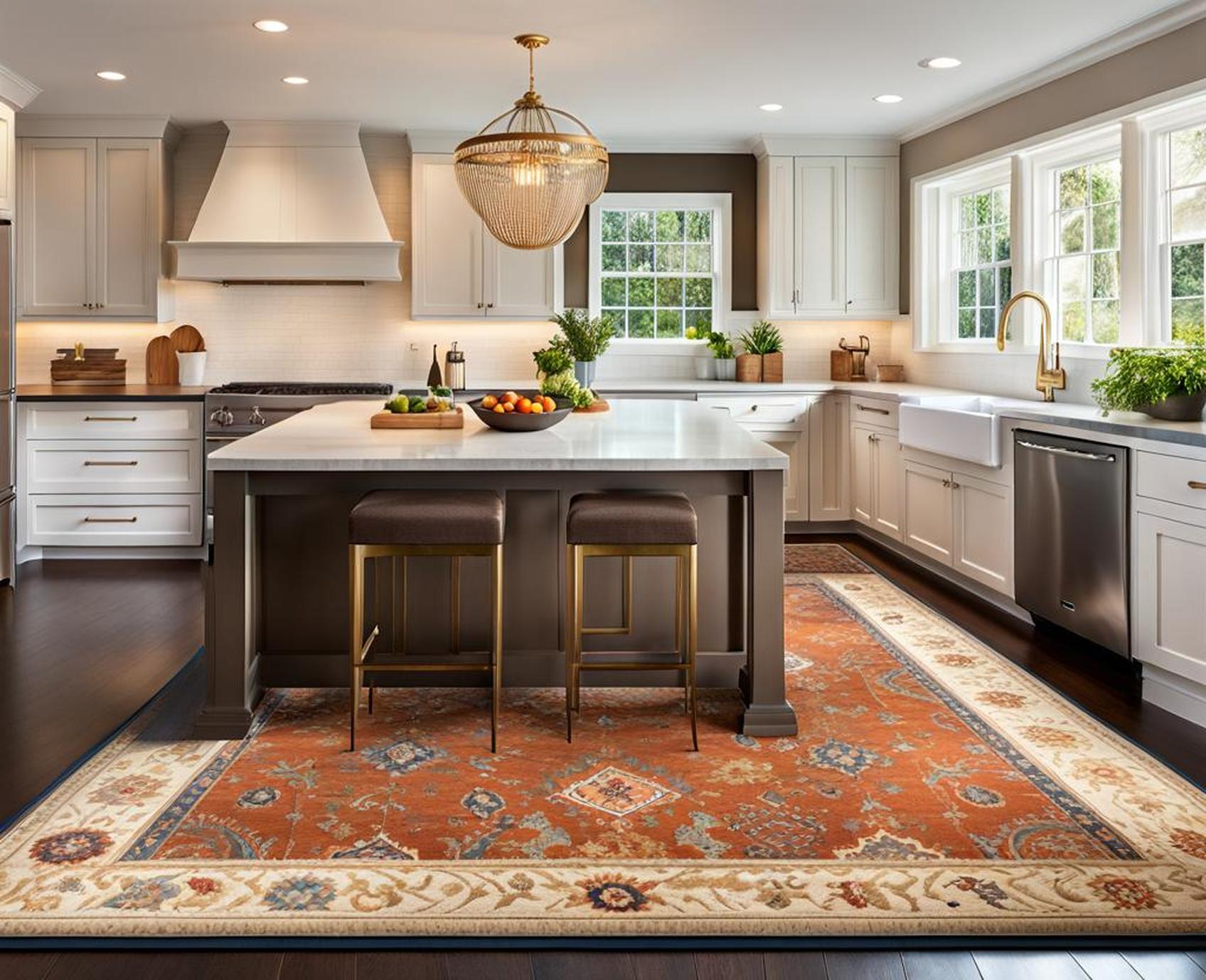Finding the ideal kitchen rug requires careful consideration of the space, your lifestyle, and desired aesthetics. With so many options on the market, choosing the right material is key to getting a rug that offers durability, easy maintenance, and stylish good looks.
Durability Matters Most in High-Traffic Kitchens
Kitchens endure a lot of wear and tear. From cooking splatters to pet accidents and kids’ spills, rugs in kitchens really take a beating. That’s why durability should be your top priority when shopping for a kitchen rug.

Look for rug materials that are stain resistant, colorfast, and able to withstand heavy foot traffic. Synthetic fibers like polyester and olefin tend to be the most durable options.
- Polyester rugs are affordable, easy to clean, and resistant to stains, mildew, and fading. Polyester offers a nice combination of durability and style.
- Olefin, also called polypropylene, makes lightweight yet strong kitchen rugs. Olefin rugs resist moisture, humidity, and mildew.
- Vinyl or PVC rugs are waterproof and very easy to keep clean. Vinyl rugs aren’t easily damaged by spills or high traffic.
While natural fiber rugs add texture and warmth, they are less impervious to spills and moisture. Wool and jute rugs are more prone to staining than synthetic ones. Still, wool rugs hold up well overall in kitchens.
Style and Design Elements
Once you’ve zeroed in on durable materials, consider the size, color and design elements that will complement your existing kitchen decor. Whether your kitchen style is modern, traditional, or farmhouse, you’ll find a rug to match.
Size Options
Take measurements of your kitchen space and choose either a large area rug or more narrow runners. Runners are ideal for galley kitchen floor plans, running between cabinets and appliances. Area rugs can define cooking, prep and eating zones in open concept kitchens.
Color Palette
While colorful, patterned rugs can be pretty, solid neutral hues tend to be more versatile in kitchens. Beige, brown, gray and ivory rugs seamlessly match most color schemes. Darker tones like black or navy also work well. Just avoid light pastels that will show every stain.
Patterns
To make a decor statement, add rugs with graphic prints, florals and geometric shapes. Just take care that the patterns don’t compete with an already busy kitchen design. Subtle textures like waffle weave and cable knits blend easily. For a farmhouse vibe try vintage style rugs.
Prioritize Plush Comfort
Consider the plushness and cushioning you want underfoot. Long shaggy piles feel decadent but not in high traffic zones. The fibers can trap dirt and liquids. For prep areas, a low flatweave style is better.
Medium pile Heights around a half-inch are ideal for comfort yet practicality. Wool and polyester offer nice density. Just make sure the backing grips flooring to avoid slips.
| Rug Pile Heights | Best Suited For |
|---|---|
| Low pile and flatweave | Cooking and prep zones |
| Medium 1/2″ pile | Multi-use kitchens |
| High shag piles | Dining and lounge areas |
Don’t Forget Safety
Preventing slips and falls is a top priority in kitchens. Choosing a non-skid rug is especially important if you have children or elderly family members at home.
Seeking rugs with rubber backing or gripping undersides will ensure they stay put on floors. Always use non-slip rug pads, securing corners and edges. This provides extra traction and cushioning.
Also steer clear of rugs with fringes or high shag piles that pose trip hazards. Loop piles are safer than cut piles which can loosen over time.
Seek Out Easy Maintenance
Kitchen rugs need frequent cleaning to look their best. When evaluating materials, check if they are prone to holding stains or smells after washing.
Synthetics like polyester clean up beautifully. Natural fibers like wool and cotton may require more care. However, colorfast wool rugs can be spot treated and vacuumed to remove grime.
Microfiber and olefin kitchen rugs are nice since you can toss them in the washing machine. Just avoid delicate fabrics like silk or viscose that require dry cleaning.
Choosing the Right Size
You’ll want your kitchen rug to fit the space properly. Measure the open floor area and add an extra 12-18 inches all around. This prevents it from looking dwarfed or cluttered.
For runners between cabinets and islands, allow an extra foot of length. Don’t size down too small in hopes of saving money. An undersized rug will constantly move and buckle.
Typical Kitchen Rug Dimensions
- In front of sink/stove – 2′ x 3′ up to 4′ x 6′
- Kitchen island – At least 2 feet longer than island width
- Galley kitchen runner – Width of floor gap plus 12″ on each side
Set Your Budget Expectations
Setting realistic budget expectations will help narrow your options. Synthetic rugs are more affordable than wool, averaging $50-150 for a medium sized rug.
Natural fibers like wool, cotton and jute cost more – from $200 up to $600+ for large or custom sizes. But the higher quality can justify the price long-term.
When to Splurge vs Save
- Splurge on rugs in high traffic cooking zones
- Save on dining area rugs that see lighter use
- Shop sales to get discounts on normally pricey wool rugs
Choosing a rug for a kitchen requires balancing durability, style, comfort underfoot, safety, easy maintenance, and budget. Opt for materials like polyester and olefin that offer longevity and practicality. Bring in your decorative charm through colors, cool patterns and quality craftsmanship. Measure properly and use non-slip pads. With the right rug choice, your kitchen floors will stay looking fabulous for years.
